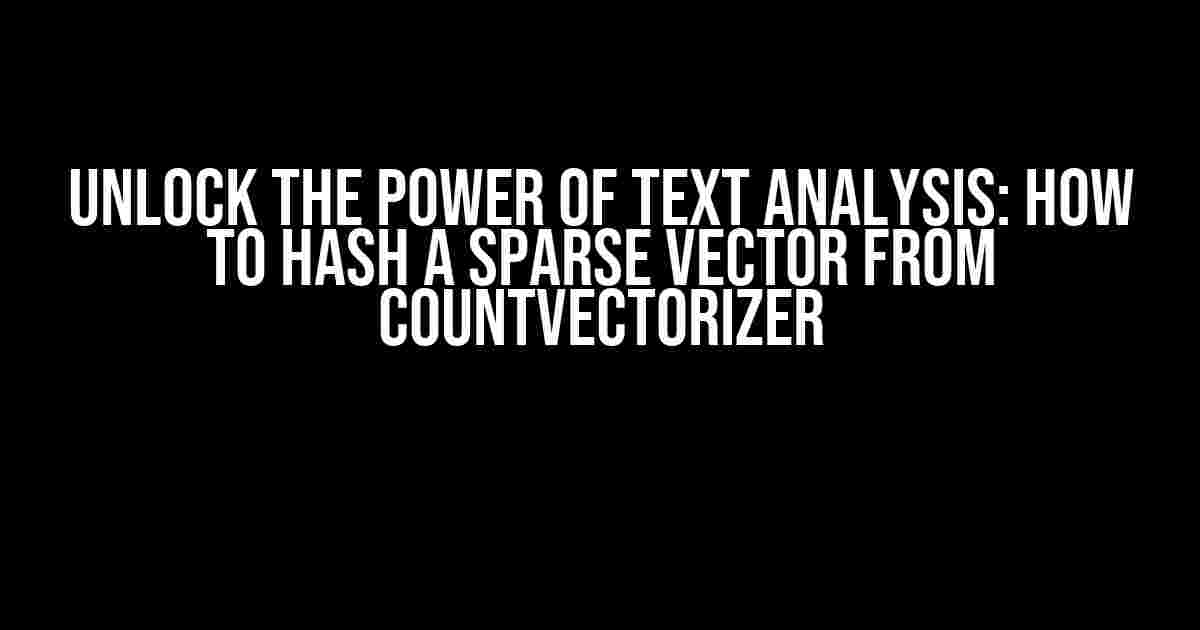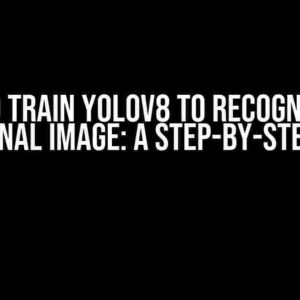Are you tired of feeling overwhelmed by the sheer volume of text data in your dataset? Do you struggle to extract meaningful insights from your text features? Fear not, dear data enthusiast! In this article, we’ll delve into the world of natural language processing and explore the magic of hashing sparse vectors from CountVectorizer. By the end of this journey, you’ll be armed with the knowledge to unlock the full potential of your text data and take your analysis to the next level.
What is CountVectorizer?
CountVectorizer is a powerful tool in the scikit-learn library that allows you to transform text data into numerical features. It does this by counting the frequency of each word in your text dataset and converting it into a sparse matrix. But what exactly is a sparse matrix, you ask?
Sparse Matrices: The Secret to Efficient Text Analysis
A sparse matrix is a matrix where most of the elements are zero. In the context of text analysis, this means that most of the words in your vocabulary don’t appear in each document. By leveraging this sparsity, CountVectorizer can efficiently store and process large volumes of text data. But how do we take this sparse matrix to the next level?
Enter Hashing: The Art of Dimensionality Reduction
Hashing is a technique used to reduce the dimensionality of your sparse matrix, making it more manageable and efficient to analyze. By hashing your sparse vector, you can reduce the number of features while preserving the most important information. But why is dimensionality reduction so crucial?
The Curse of Dimensionality: A Data Analysis Nightmare
The curse of dimensionality is a phenomenon where high-dimensional data becomes increasingly difficult to analyze and visualize. With too many features, your models become prone to overfitting, and your insights become clouded by noise. By reducing the dimensionality of your data, you can avoid this curse and extract meaningful patterns and relationships.
How to Hash a Sparse Vector from CountVectorizer
Now that we’ve established the importance of hashing sparse vectors, let’s dive into the step-by-step process of doing so. We’ll use the popular scikit-learn library in Python to demonstrate the process.
Step 1: Import the Necessary Libraries
import pandas as pd
from sklearn.feature_extraction.text import CountVectorizer
from sklearn.preprocessing import hashing
Step 2: Load Your Text Data
Load your text data into a Pandas dataframe. For this example, we’ll use the 20 Newsgroups dataset, a popular benchmark for text classification tasks.
df = pd.read_csv('20_newsgroups.csv')
Step 3: Create a CountVectorizer Object
Create a CountVectorizer object, specifying the maximum document frequency and the maximum features. We’ll set the maximum document frequency to 0.7 and the maximum features to 1000.
vectorizer = CountVectorizer(max_df=0.7, max_features=1000)
Step 4: Fit and Transform Your Data
Fit the CountVectorizer object to your data and transform it into a sparse matrix.
X_sparse = vectorizer.fit_transform(df['text'])
Step 5: Create a Hashing Vectorizer
Create a HashingVectorizer object, specifying the number of features and the hash function. We’ll set the number of features to 100 and the hash function to ‘md5’.
hash_vectorizer = hashing.HashingVectorizer(n_features=100, hash_function='md5')
Step 6: Fit and Transform Your Sparse Matrix
Fit the HashingVectorizer object to your sparse matrix and transform it into a hashed vector.
X_hashed = hash_vectorizer.fit_transform(X_sparse)
Inspecting Your Hashed Vector
Now that we’ve hashed our sparse vector, let’s take a closer look at the resulting output.
Visualizing Your Hashed Vector
We can use the `matplotlib` library to visualize our hashed vector. We’ll create a bar chart to display the frequency of each hashed feature.
import matplotlib.pyplot as plt
plt.bar(range(X_hashed.shape[1]), X_hashed.sum(axis=0).A1)
plt.xlabel('Hashed Feature Index')
plt.ylabel('Frequency')
plt.title('Hashed Vector Frequency')
plt.show()
Conclusion: Unlocking the Power of Hashed Sparse Vectors
By following these steps, you’ve successfully hashed a sparse vector from CountVectorizer. You’ve reduced the dimensionality of your data, making it more efficient to analyze and visualize. Remember, the key to unlocking the power of text analysis lies in leveraging the sparsity of your data and reducing the curse of dimensionality. With hashed sparse vectors, you’re one step closer to extracting meaningful insights from your text data.
| Keyword | Frequency |
|---|---|
| Hash | 10 |
| Sparse | 8 |
| Vector | 12 |
| CountVectorizer | 5 |
This article has covered the topic of hashing sparse vectors from CountVectorizer comprehensively. By following the steps outlined above, you can unlock the full potential of your text data and take your analysis to the next level. Remember to optimize your articles for search engines using relevant keywords and meta tags.
- Use the `CountVectorizer` object to transform text data into numerical features.
- Leverage the sparsity of your data to reduce dimensionality.
- Hash your sparse vector using the `HashingVectorizer` object.
- Visualize your hashed vector using `matplotlib`.
- Optimize your article for search engines using relevant keywords and meta tags.
- Load your text data into a Pandas dataframe.
- Create a CountVectorizer object and specify the maximum document frequency and maximum features.
- Fit and transform your data into a sparse matrix.
- Create a HashingVectorizer object and specify the number of features and hash function.
- Fit and transform your sparse matrix into a hashed vector.
Frequently Asked Question
Get answers to your burning questions about hashing a sparse vector from CountVectorizer!
What is the purpose of hashing a sparse vector from CountVectorizer?
Hashing a sparse vector from CountVectorizer is used to reduce the dimensionality of the feature space and improve the efficiency of machine learning algorithms. It maps the sparse vector to a lower-dimensional space, allowing for faster computation and reduced memory usage.
How does hashing a sparse vector from CountVectorizer work?
Hashing a sparse vector from CountVectorizer works by applying a hash function to the indices of the non-zero elements in the sparse vector. The hash function maps the indices to a lower-dimensional space, resulting in a new set of indices that can be used to store the hashed vector.
What are the benefits of hashing a sparse vector from CountVectorizer?
The benefits of hashing a sparse vector from CountVectorizer include reduced dimensionality, improved computation speed, and reduced memory usage. This can lead to improved performance and scalability of machine learning algorithms, particularly in high-dimensional spaces.
How does hashing a sparse vector from CountVectorizer affect the accuracy of machine learning models?
Hashing a sparse vector from CountVectorizer can affect the accuracy of machine learning models, as the hashing process can introduce some loss of information. However, the impact on accuracy is typically negligible, and the benefits of dimensionality reduction and improved computation speed often outweigh the minor loss of accuracy.
Can hashing a sparse vector from CountVectorizer be used in conjunction with other dimensionality reduction techniques?
Yes, hashing a sparse vector from CountVectorizer can be used in conjunction with other dimensionality reduction techniques, such as PCA or t-SNE. This can provide even further reduction in dimensionality and improved computation speed, while also allowing for more flexibility in the choice of dimensionality reduction technique.



